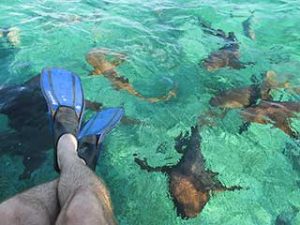Hol Chan Marine Reserve – Ambergris Caye, Belize

Photo copyright Alex Berger
The reserve is divided into four distinct zones including vital mangrove and sea grass bed habitats, as well as coral reefs and an area where species of sharks and rays congregate known as Shark Ray Alley. This unique combination of habitats, diversity of marine life, and the excitement of swimming with large numbers of nurse sharks and stingrays has made Hol Chan Marine Reserve the most popular diving and snorkeling site in all of Belize.
Although small, Hol Chan contains an extraordinarily high biomass of fishes per unit area of reef including enormous schools of grunts and snappers and huge black groupers and grey snappers. The reserve also contains seven more species of commercial fishes than areas subject to fishing. Particularly important to the replenishment of the fisheries is the presence of large fishes within the reserve because of their disproportionately large contribution to egg production. In addition to boosting reproductive output, the large fish in the reserve may also play an important role in protection of species, which are vulnerable to fishing.
Locals themselves overwhelmingly believe that the high level of protection given to Hol Chan is the key to their enhanced welfare. Indeed, the most common complaint is that the reserve should be more protected from tourists, in particular those in the care of non-local guides from cruise ships. This case study shows that marine protected areas can and do work for a number of different purposes.
To read more:
- Roberts, C. M., and N. V. C. Polunin. “Hol Chan: demonstrating that marine reserves can be remarkably effective.” (379K PDF file) Coral Reefs 13.2 (1994): 90-90.
- Polunin, N. V. C., and C. M. Roberts. “Greater biomass and value of target coral-reef fishes in two small Caribbean marine reserves.” (790K PDF file) Marine Ecology-Progress Series 100 (1993): 167-167.


